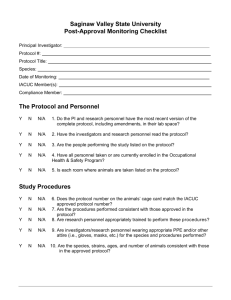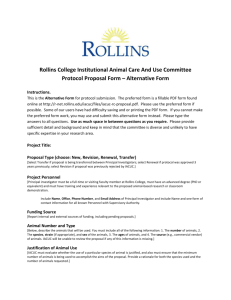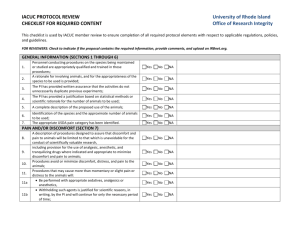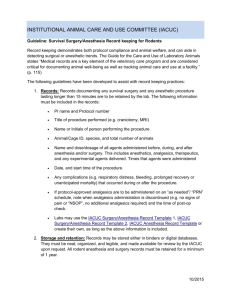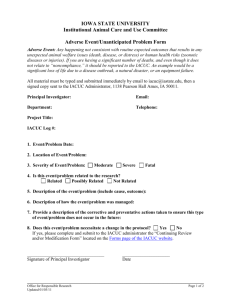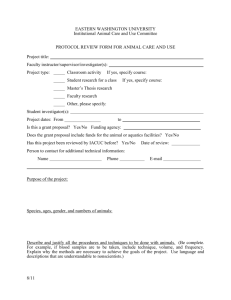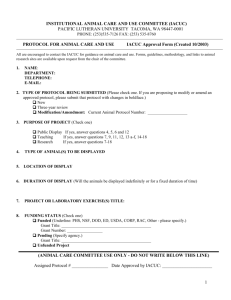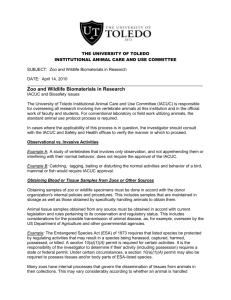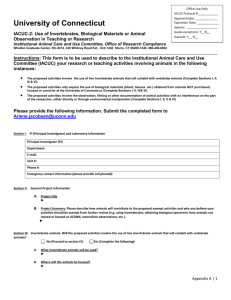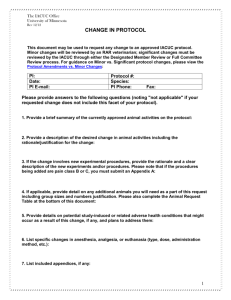Name Phone extension E-mail Initials and Date
advertisement
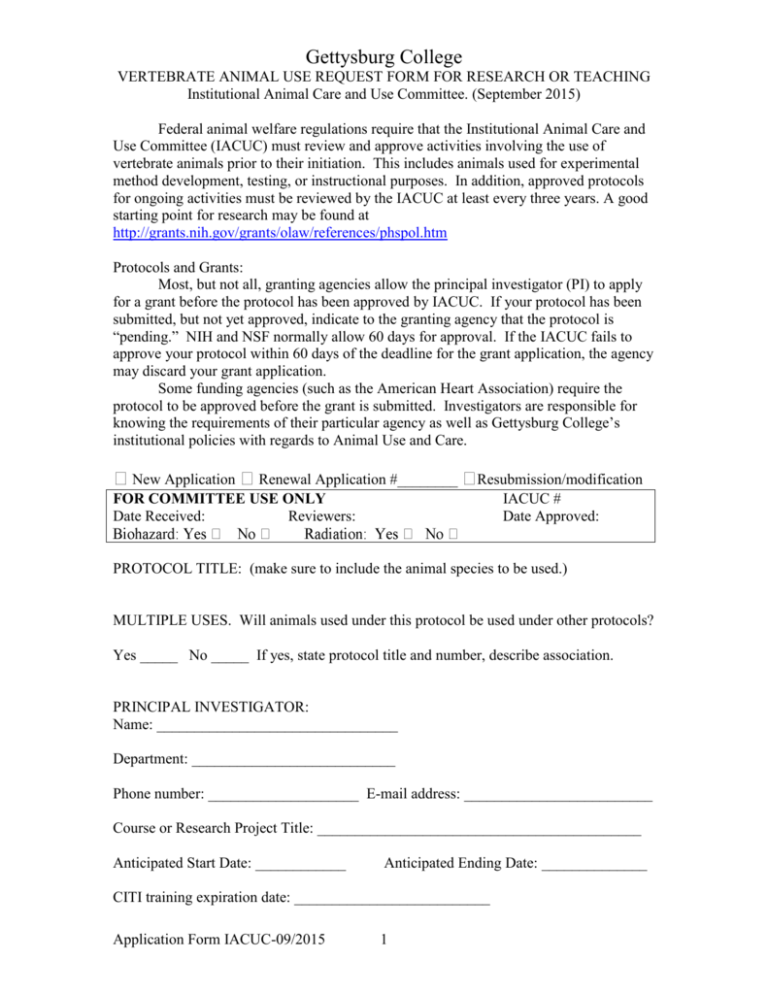
Gettysburg College VERTEBRATE ANIMAL USE REQUEST FORM FOR RESEARCH OR TEACHING Institutional Animal Care and Use Committee. (September 2015) Federal animal welfare regulations require that the Institutional Animal Care and Use Committee (IACUC) must review and approve activities involving the use of vertebrate animals prior to their initiation. This includes animals used for experimental method development, testing, or instructional purposes. In addition, approved protocols for ongoing activities must be reviewed by the IACUC at least every three years. A good starting point for research may be found at http://grants.nih.gov/grants/olaw/references/phspol.htm Protocols and Grants: Most, but not all, granting agencies allow the principal investigator (PI) to apply for a grant before the protocol has been approved by IACUC. If your protocol has been submitted, but not yet approved, indicate to the granting agency that the protocol is “pending.” NIH and NSF normally allow 60 days for approval. If the IACUC fails to approve your protocol within 60 days of the deadline for the grant application, the agency may discard your grant application. Some funding agencies (such as the American Heart Association) require the protocol to be approved before the grant is submitted. Investigators are responsible for knowing the requirements of their particular agency as well as Gettysburg College’s institutional policies with regards to Animal Use and Care. New Application Renewal Application #________ FOR COMMITTEE USE ONLY Date Received: Reviewers: Resubmission/modification IACUC # Date Approved: PROTOCOL TITLE: (make sure to include the animal species to be used.) MULTIPLE USES. Will animals used under this protocol be used under other protocols? Yes _____ No _____ If yes, state protocol title and number, describe association. PRINCIPAL INVESTIGATOR: Name: ________________________________ Department: ___________________________ Phone number: ____________________ E-mail address: _________________________ Course or Research Project Title: ___________________________________________ Anticipated Start Date: ____________ Anticipated Ending Date: ______________ CITI training expiration date: __________________________ Application Form IACUC-09/2015 1 PERSONNEL INVOLVED: Everyone working on this protocol (other than veterinary services and people who normally provide animal care) must initial and date it to verify that they have read it and will comply with the procedures described. Please submit revised list as personnel change. Alternatively, a statement may be included that places full responsibility on the principal investigator for ensuring that everyone working on the project will comply with all procedures described in the protocol. Name Phone extension E-mail Initials and Date All personnel working with animals must complete the appropriate training modules on the CITI website. Select the “working with the IACUC course” and then select the species-specific course for any animals that you will be working with. If you are doing any procedures that can cause pain or discomfort for mice or rats you also need to complete the “minimizing pain and distress” module. https://www.citiprogram.org/ BRIEF SUMMARY: Briefly explain in language understandable to a layperson, the aim of the study, time sequence of procedures, and final disposition of animals. For resubmissions, state what has been accomplished under this protocol so far. Please define acronyms and abbreviations. Application Form IACUC-09/2015 2 SECTION II See also: http://vetmed.duhs.duke.edu/Guidelines.html 1A. ANIMALS TO BE USED IN THIS PROTOCOL SPECIES: STRAIN: SEX: COMMON NAME: AGE or WEIGHT RANGE: NUMBER OF ANIMALS TO BE USED: TOTAL: Year 1: Year 2: Year 3: 1B. EXPLAIN HOW THIS NUMBER WAS DETERMINED: 1C. PROVIDE A RATIONALE FOR ANIMAL USE: 1D. PROVIDE A RATIONALE FOR THE APPROPRIATENESS OF THE SPECIES SELECTED: 2. SOURCE(S): Application Form IACUC-09/2015 3 3A. HUSBANDRY: Standard laboratory animal resource husbandry (routine) Describe any specialized or non-laboratory animal resource husbandry (see below) (surgically altered animals, special light cycles, diets, and other departures from standard practice) 3B. CAGE ENRICHMENT: All animals housed in cages require cage enrichment. Although not mandated, it is recommended that mice be given nesting material and rats be provided with shelter. Please describe what will be done for cage enrichment. 4. ANIMAL IDENTIFICATION METHODS: (e.g. ear tag, cage card, tattoos, etc) SECTION III 5. EXPERIMENTAL ADMINISTRATIONS/NONSURGICAL PROCEDURES List precisely the agent(s), adjuvants, vehicle, route of administration, volume (expressed in appropriate units), frequency of dosing (expressed as number of times per day), and duration of dosing. See: Volume Guidelines for Compound Administration at: http://iacuc.usu.edu/files/uploads/volume_guidelines.pdf Agent Dose (mg/kg) Application Form IACUC-09/2015 Route 4 Frequency Duration 6A. SURGERY. NO (Proceed to 8) YES. Check appropriate box: Non-survival surgery: animals euthanized without regaining consciousness Minor survival surgery: no penetration of a major body cavity Major survival surgery: penetration of a major body cavity, or surgical alteration that results in permanent physical impairment DESCRIBE SURGERY IN DETAIL. You may use a separate attachment. 6B. LOCATION. Where will surgery be performed? Aseptic surgery area? Other? (Specify location). 6C. MONITORING AND SUPPORTIVE CARE. Preoperative and intraoperative. 7A. ANESTHESIA/ANALGESIA/TRANQUILIZERS. Describe in the boxes below the agents that may be used in: a) Surgical procedures b) Other procedures (This requires consultation with a veterinarian prior to submission) Agent Dose (mg/kg) Application Form IACUC-09/2015 Route 5 Frequency 7B. CRITERIA TO ASSESS LEVEL OF ANESTHESIA. Check all that apply. Respiration rate Heart rate ECG Toe pinch Tail pinch Corneal reflex Color of mucus membranes Muscular relaxation Other (pulse oximeter, respirimeter) 7C. ANESTHESIA RECOVERY MONITORING Survival procedures only. Will analgesia be provided? 7D. POSTSURGICAL RECOVERY MONITORING. Beyond anesthetic recovery. 8. BLOOD COLLECTIONS. Will blood be collected from animals? If NO, proceed to the next question. If YES, then state METHOD, FREQUENCY, and VOLUME OF EACH WITHDRAWL. Also state the estimated percentage of total volume withdrawn per day or per week. See Guidelines for Blood Sample Withdrawal at: http://iacuc.usu.edu/files/uploads/blood_sample_withdrawal.pdf http://vetmed.duhs.duke.edu/GuidelinesforBloodWithdrawal.html 9. RESTRAINTS. Will unanaesthetized animals be restrained (exclude momentary procedures such as for blood draws, injections, dosing, etc.)? If NO, proceed to next section. If YES, then state purpose/method/duration/and frequency. Also describe how animals will be observed during periods of restraint, and what training/acclimatization procedures are to be carried out beforehand. 10. FOOD AND WATER. Will food be withheld for more than 24 hours or water for more than 8 hours? If YES, state purpose/duration/ and monitoring procedure. Application Form IACUC-09/2015 6 11. REMOVAL FROM NORMAL ANIMAL FACILITIES. Will animals be kept in areas outside of the animal facility for more than a working day? If YES, describe location, length of time, and reason. 12. HAZARDOUS AGENTS. Will animals be subjected to any hazardous agents such as pathogenic organisms, chemical carcinogens, recombinant DNA/RNA, or radioactivity? Will animals be a source of contamination to personnel or other animals? If YES, describe agent(s), risks, how they will be used, containment procedures, and precautions for proper disposal of animals and waste. Also, document authorization or clearance from health and safety departments, if applicable. 13. EUTHANASIA. State the agent, dose (mg/kg), and route of administration of substances that will be used for euthanasia of test animals and moribund animals. If this does not comply with the AVMA Panel on Euthanasia, provide justification. See the OLAW Guide Book section C.2.b and Appendix D, Euthanasia Guidelines at http://grants.nih.gov/grants/olaw/GuideBook.pdf Application Form IACUC-09/2015 7 14. CRITERIA USED TO ASSESS PAIN/DISTRESS/DISCOMFORT. Check all that apply. See Guidebook section C.2.d http://grants.nih.gov/grants/olaw/GuideBook.pdf Loss of appetite. Loss of weight Restlessness. Abnormal resting postures in which the animal appears to be sleeping or is hunched up. Licking, biting, scratching, or shaking a particular area. Failure to show normal patterns of inquisitiveness. Failure to groom, causing an unkempt appearance. Guarding (protecting the painful area). Loss of mobility. Red stain around eyes of rats. Unresponsiveness. Self-mutilation. Labored breathing. Other _____________________________________. 15. LIMITING PAIN AND DISCOMFORT TO ANIMALS. Describe procedures designed to assure that discomfort and pain will be limited to that which is unavoidable for the conduct of scientifically valid research. For the Official USDA-AWA (Animal Welfare Act) Pain/Distress Categories: see http://www.iacuc.cornell.edu/documents/IACUC009.01.pdf NOTE: Category D and E experiments require that the investigator do a literature search for alternatives (Replacement, Refinement, Reduction) to ensure that animal pain/distress is minimized. 16. ALTERNATIVES (for category D and E experiments). Consideration of alternatives for each procedure that may cause pain or distress must state sources consulted, such as Biological Abstracts, Index Medius, Medline, Agricola, Biosis, Psychinfo, Zoological Record, and others. At a minimum, include databases searched, date searched, years covered, and keywords and/or search strategy used. Reduction, replacement, and refinement (the three R’s) must all be addressed. See also: http://www.upenn.edu/regulatoryaffairs/Documents/iacuc/guidelines/iacucguidelineliteraturesearch.pdf http://research.oregonstate.edu/files/iacuc/3rs_and_literature_search.pdf Application Form IACUC-09/2015 8 17. PRINCIPAL INVESTIGATOR STATEMENT OF ASSURANCE: Check the appropriate answer, YES or NO (Note: A negative answer to any statement requires a detailed, written explanation. YES NO No animal will be used in more than one major operative procedure from which it is allowed to recover, unless scientifically justified or required as a veterinary procedure. Paralytics will not be used without appropriate anesthesia. Medical care for animals will not be withheld and will be available and provided or supervised as necessary by a veterinarian. The animal’s living conditions, including housing, feeding, psychological enrichment programs, exercise, and non-medical care, will be appropriate for the species, will contribute to their health and comfort, and will not deviate from USDA standards. Animals that would otherwise experience severe or chronic pain/distress that cannot be relieved will be euthanized at the end of the procedure, or if appropriate, during the procedure. Personnel conducting animal procedures will be appropriately qualified and trained in those procedures, and the training and qualifications of such personnel will be adequate to carry out the procedures. I certify that I will notify the IACUC regarding any unexpected study results that impact the animals. I certify that I am familiar with and will comply with all pertinent institutional, state, and federal rules and policies. I certify that I am familiar with and will abide by all pertinent institutional, state, and federal rules and policies, and will notify the IACUC regarding any unexpected study results that impact the animals. __________________________________ Signature of Principal Investigator(s) ___________________ Date __________________________________ Signature of Department Chairperson ___________________ Date Application Form IACUC-09/2015 9
